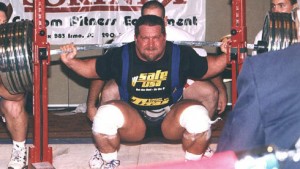
December 3, 2010
Biomechanics of the Squat
My article, Squatting kinematics and kinetics and their application to exercise performance has just been published in the current issue of the Journal of Strength and Conditioning Research. The article is an extensive review of the literature on the biomechanics of the squat in depth, and explores its relevance to strength and muscle development. Here are the conclusions of the paper based on a summation of research:
1. Squat depth should be consistent with the goals and abilities of the individual. Because peak patellofemoral compressive forces occur at or near maximum knee flexion, those with patellofemoral disorders should avoid squatting at high flexion angles. For those with existing injury or previous reconstruction of the PCL, it is best to restrict flexion to 50° to 60° so that posterior shear is minimized. Quadriceps development is maximized by squatting to parallel, with no additional activity seen at higher flexion angles. Hip extensor moments increase with increasing squat depth, so full squats may be beneficial for those seeking to maximize strength of the hip musculature.
2. Speed of movement should be based on goal-oriented specificity to the force-velocity curve. However, given that speed of movement has been shown to significantly increase both compression and shear forces, there is a tradeoff between optimal transfer of performance and risk of injury. This is especially true on the eccentric aspect of the move where rapid deceleration generates exceedingly high joint forces at the knee. Failure to control descent can result in the ballistic contact between the hamstrings and calf muscles, which can cause a dislocating effect on the knee ligaments. Therefore, unless athletic goals specifically dictate otherwise, squat descent should always be executed in a controlled fashion, with a 2 to 3 second eccentric tempo considered a general guideline.
3. A wider stance squat is preferable for those seeking optimal development of the hip adductors and hip extensors, whereas a closer stance is more appropriate for targeting development of the gastrocnemius. Stance can also be varied to alter joint-related forces: a narrow stance helps to minimize patellofemoral and tibiofemoral compression while a wider stance results in less forward knee translation and thus reduces shear.
4. Low bar back squats tend to produce greater hip extensor torque and less knee extensor torque compared with high bar back squats. However, the magnitude of forces for both movements are well tolerated by the associated joint structures, making either position suitable for the majority of lifters. The front squat produces significantly lower knee compression and lumbar stress in comparison with back squats, making it a viable alternative for those suffering from various knee and back ailments. Front squats also can be particularly beneficial for those competing in weight lifting events because it is an essential component in performance of the clean.
5. Fatigue can have a deleterious effect on squatting technique, potentially leading to knee instability and increased lumbar shear. If the lifter opts to squat to momentary muscular failure, it is advisable to have a spotter to ensure safety.
In addition to the aforementioned joint-specific recommendations, some joint-specific recommendations can be made as to squat-related performance variables.
Ankle Joint: Significant strength and mobility is required at the ankle for proper squat performance. Feet should be positioned in a comfortable stance that allows the knees to move in line with the toes. Because the feet are outwardly rotated approximately 7° in anatomic position, this can be considered a good starting point to ensure proper patellar tracking. If the lifter’s heels rise off the floor during the eccentric phase of movement, efforts should be made to improve flexibility around the talocrural and subtalar joints. Orthotics can be worn to help correct joint imbalances and misalignment. If necessary, a barbell plate or other flat object can be placed underneath the heels to aid in stability.
Knee Joint: Given the fact that shear forces are increased as the knees move past the toes during the downward phase of the squat, attempts should be made to avoid significant forward knee translation on descent. However, this should not be done at the expense of compromising form at the hips and spine, which can place the lumbar region in a biomechanically disadvantageous position and significantly increase spinal shear. To reduce tibiofemoral and patellofemoral moments, the lifter should sit back into the squat during descent and resist pushing the knees forward. There should be no varus or valgus motion throughout exercise performance.
Hip Joint: Given the close relationship between movement at the hips, pelvis, and lumbar spine during dynamic squatting, hip mobility is extremely important for proper squat performance, especially at higher flexion angles. Poor joint mobility can lead to greater forward lean and thus increased spinal shear. Although some lifters attempt to increase hip flexion by using posterior pelvic movement during squat descent, this can heighten lumbar stress and is thus not advisable. Flexibility training specific to the hip musculature can help to increase hip mobility and facilitate better squat performance.
Spine: The spine is the most vulnerable of the joints during squatting. Because the lumbar spine is better able to handle compressive force than shear, a normal lordotic curve should be maintained in this region, with the spinal column held rigid throughout the movement. Proper spinal alignment is facilitated by maintaining a straight ahead or upward gaze, which reduces the tendency for unwanted flexion. Although some forward lean is sometimes necessary to maintain stability especially when performing deep squats, attempts should be made to keep the trunk as upright as possible to minimize shear. No lateral movement should take place at any time.
Stay Fit!
Brad
No Comments
No comments yet.
RSS feed for comments on this post.
Sorry, the comment form is closed at this time.






 Entries (RSS)
Entries (RSS)



